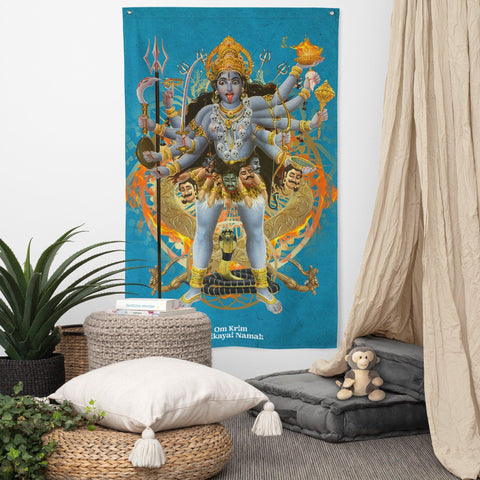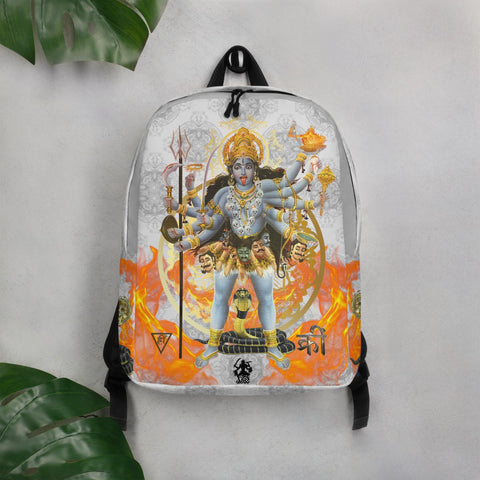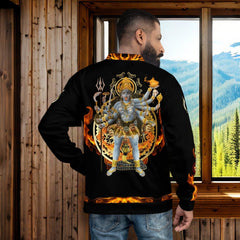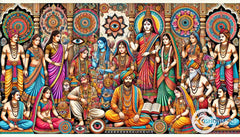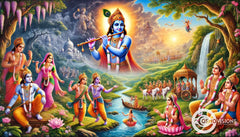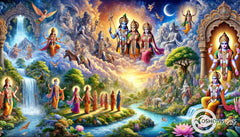Hindu Goddess Kali: The Iconography of Goddess of Time and Liberation
Posted by Massimiliano Geraci
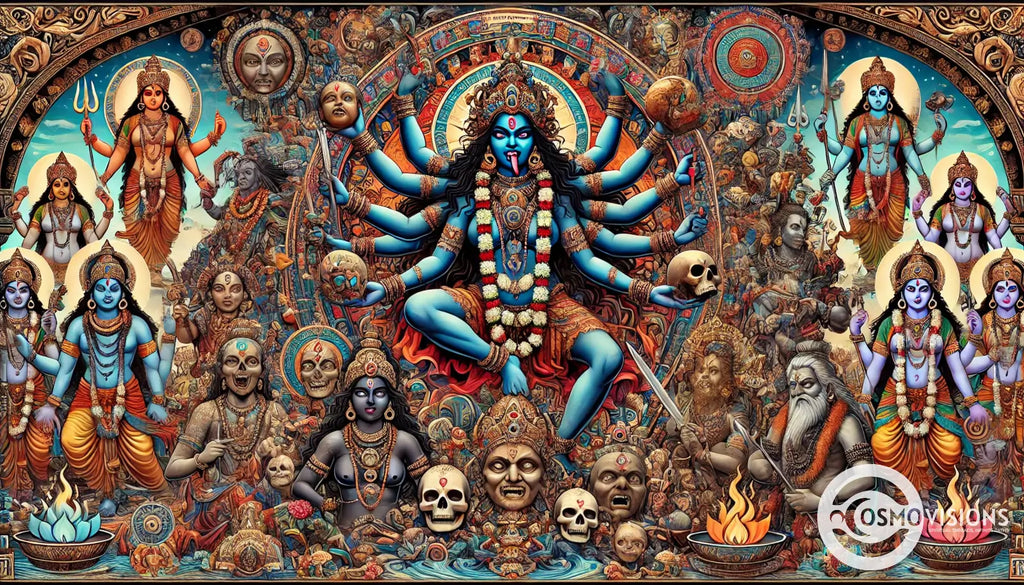
Exploring the mysteries of Hindu deities can sometimes feel overwhelming, especially when examining the intricacies of their stories, symbols, and rituals. One goddess who stands out for her power and depth is Kali, the Goddess of Time, Death, and Liberation.
This enigmatic deity embodies themes that are at once ancient and surprisingly relevant to our modern spiritual quests.
Kali's iconography is rich with symbolism: Kali wears a garland of skulls and holds a severed head, signifying her dominion over life and death. These images convey deep messages about the cycle of birth and rebirth, as well as liberation from earthly bonds.
Our article will guide you through understanding Kali's symbolic garments and weapons, her role in Hindu mythology alongside God Shiva, and how she continues to be worshipped today by devotees around the world.
Learn about Kali's transformative power.
Who is the Hindu Goddess Kali?
Shifting from the broader introduction to Hindu deities, we next explore God Kali, a figure of profound significance in Hinduism. Kali, often referred to as Goddess Durga's fierce form, embodies liberation and destruction.
Unlike any other deity, her origins trace back to ancient texts like the Vedas and Puranas where she emerges as a symbol of time (kāla), change, and beyond-death realities. Known for her dark complexion and formidable appearance, Kali holds a distinct place within the pantheon as both protector and destroyer. In many respects, Kali appears to be an intensely frightening manifestation of the sacred, with her associations with blood sacrifice, death, and destruction.
Kali’s history is rich with tales of vanquishing demons such as Raktabīja during the battle depicted in Devi Mahatmyam. With every drop of Raktabīja's blood that fell to ground sprouting into new demons, it was Ma Kali who prevented these drops from reaching mother earth by catching them on her tongue—a vivid imagery inscribed in sacred texts underscoring her indomitable might and divine mother-ly love safeguarding creation from cycles of evil.
Her manifestations range from Bhadra Kali to Dakshina Kali—each revealing facets of divine femininity unbounded by conventional morality or order thereby challenging devotees to see divine force in rawest forms.
Through these narratives and iconographical representations across Bengal to South India, worshipped fervently through festivals like Navaratri and Vijayadashami, she teaches lessons on power dynamics rooted deeply within nature's law—nurturing yet annihilating when necessary for cosmic balance restoration.
Origins and History of Kali
Kali's origins and history takes us back to ancient Hindu scriptures where she is depicted as a powerful force of nature, emblematic of time, change, power, and destruction.
Initially emerging in Sanskrit texts like the "Devi Mahatmyam," Kali's narrative weaves through centuries of worship and reverence within the Hindu pantheon. Her portrayal as a fierce warrior goddess battling demons such as Mahishasura and Raktabija speaks volumes about her role in combating evil forces and protecting cosmic order.
Kali’s historical significance extends beyond mythological tales; she symbolizes liberation from ego and attachments, embodying Shakti or divine feminine energy. This transition underscores her importance not just as a deity associated with death but also with rebirth and regeneration.
Temples dedicated to Kali, such as those in Bengal where she is ardently worshipped during festivals like Kali Puja, highlight her enduring presence in devotion across ages. Through rituals, hymns (mantras), iconography portraying her dark blue skin adorned with skulls and severed heads, devotees seek blessings for strength against adversaries both spiritual and worldly.
Forms of Kali: From Bhadra Kali to Dakshina Kali
Exploring the diverse representations of Kali reveals a spectrum ranging from Bhadra Kali to Dakshina Kali, each embodying unique aspects and teachings. Bhadra Kali, known as the benevolent form, presents a nurturing side of the deity, resonating deeply with devotees seeking protection and love.
This manifestation draws upon the goddess's role as Dark Mother Goddess, highlighting her compassionate nature to her children.
On another end sits Dakshina Kali, showcasing a fiercer stance. Here she stands victorious over evil forces, symbolized by her stance above Shiva – an image that conveys power over death and mastery over time (kala).
It is this portrayal that emphasizes liberation through destruction of ego and ignorance, teaching followers about life's impermanence and the illusionary nature of earthly ties. Through these varied forms – samhara kali to raksha kali – worshipers connect with different facets of femininity from fierce warriors fighting demons like Raktabija to protective mothers guiding their devotees through challenges.
Kali's Role in Hindu Mythology
Kali stands as a central figure in Hindu mythology, embodying the goddess of time, death, and liberation. She emerges from the feminine form of divine energy, known as Shakti, and plays a pivotal role in the battle against evil forces.
Kali's appearance marked significant moments; her arrival was during a fierce fight with demon king Mahishasura and later with demon Raktabija. During these battles, every drop of blood Raktabija shed gave birth to clones of himself.
Kali defeated this seemingly invincible foe by preventing his blood from reaching the ground and consuming him, showcasing her power over life and death.
Her interactions with Lord Shiva are iconic in Hindu tradition—Kali is seen standing on Shiva’s chest in many depictions. This powerful image symbolizes balance: while Kali represents destruction and chaos necessary for renewal, Shiva embodies pure consciousness—an underlying calm amidst turmoil.
Their relationship illustrates how life feeds on death for rebirth—a cycle vital to cosmic order. Through these mythological tales woven across centuries within texts like Devi Mahatmyam and through rituals observed during Durga Puja festivals or veneration at various temples around South Asia including Assam and Bengal, Kali’s worshipped not just as a destroyer but also as a protective mother-figure who wards off evil influences ensuring harmony within creation's dynamic equilibrium.

Why is Kali Worshipped?
Devotees worship Kali, seeing her as the goddess of time, death, and liberation. Her fierce form teaches that life's ultimate truth is beyond good and evil, emphasizing liberation through knowledge rather than fear.
Across centuries and cultures, she remains a symbol of empowerment and destruction of negativity. As the greater form of Kali emerges to protect the universe from demons like Mahishasura and Raktabija, her followers find solace in her strength to overcome malevolence with divine fury.
Kali Puja festivals illuminate how deeply ingrained she is in spiritual practices across Bengal and beyond. Devotional rituals involve mantras echoing through temples dedicated to her honor, where offerings signify respect for life's cyclical nature—birth leading to death leading to rebirth.
These ceremonies connect worshippers with ancestral wisdom, asserting Kali's importance not just in mythology but in confronting everyday challenges by embracing change fearlessly.
In the darkest nights reside the most profound transformations; thus we seek Maa Kali's guidance for enlightenment.
Devotional Practices to Worship the Goddess
Worshipping the goddess Kali involves a rich tapestry of devotional practices that have evolved over centuries. These practices embody the deep reverence and love devotees hold for Kali, seeing her as a mother figure and a source of liberation.
1. Chanting Mantras: Devotees often recite specific mantras dedicated to Kali, with "Om Kreem Kalikayai Namah" being one of the most powerful. This mantra is said to invoke the goddess's energy, offering protection and empowerment to those who chant it with devotion.
2. Performing Kali Puja: Kali Puja is a significant festival celebrated in Bengal and other parts of India, usually during Diwali. The ritual involves elaborate offerings including red hibiscus flowers, rice, lentils, and sweets. Devotees also offer animal sacrifices in some traditions, symbolizing the surrender of ego and negative tendencies.
3. Displaying Statues and Images: Worship spaces often feature prominently displayed statues or images of Kali. These depictions show her with a garland of skulls around her neck, holding severed heads and weapons, wearing a skirt made of human arms, symbolizing liberation from the cycle of karma.
4. Meditation on Kali: Devotees meditate on the image or concept of Kali to internalize her qualities such as timelessness, fierceness against evil, and maternal compassion. This practice helps in overcoming personal struggles and finding inner peace.
5. Love for her children manifests through acts of charity and service in Kali’s name. Devotees engage in feeding the hungry, helping the poor, and other acts of kindness as an offering to Kali.
6. Reading Scriptures: Sacred texts like the "Devi Mahatmyam" recount tales of Kali’s battles against demons such as Raktabija. Studying these stories helps followers understand Kali’s significance within Hindu mythology and reinforces their faith in her powers.
7. Fasting on Special Days: Devotees fast during special days dedicated to Kali such as Maha Shivaratri or her appearance day known as Kalipuja Day in Bengal. Fasting purifies both body and mind, making one more receptive to divine energies.
8. Creating Artwork: Drawing or creating art related to Goddess Kali serves not only as an act of devotion but also helps spread awareness about her symbolism. Many artists find inspiration in depicting themes related to life cycles, transformations, or spiritual journeys embodied by Kali. Her iconography has inspired countless works across different mediums globally.
9. Participating in Bhajans: Groups gather to sing bhajans (devotional songs) dedicated to Goddess Kali. Music is considered a profound way to connect with divine frequencies that transform consciousness. This brings together community members sharing similar spiritual paths under their love for Kali.
10. Engaging with Tantric Practices: Some followers explore Tantra under guidance from experienced practitioners using rituals involving yantras (sacred geometry), chants, and specific rites that awaken spiritual enlightenment through union with cosmic energies represented by Kali. This clearly demonstrates an advanced level of commitment towards understanding divine mysteries.
Mantras and Symbols Associated with Kali
Kali's devotees chant powerful mantras to invoke her presence and blessings. The most revered among these is the "Kali Kavacham," a protective shield that calls upon the goddess' fierce energy for defense against spiritual and physical harm.
Equally potent, the "Kali Gayatri Mantra" seeks enlightenment by dispelling darkness and ignorance, bringing followers closer to divine wisdom. These verses connect worshippers with Kali’s transformative power and guide them through paths of liberation and self-realization.
Symbols play a crucial role in understanding Kali’s essence. Her necklace of skulls represents the seed syllables of Sanskrit, emphasizing knowledge as power over death. The severed head she holds signifies ego’s destruction, an essential step towards moksha or liberation in Hindu philosophy.
Furthermore, her black skin captures all colors, symbolizing the comprehensive nature of cosmic reality where everything originates and dissolves into Brahman—the ultimate universal consciousness.
Through these symbols, devotees grasp deeper insights into life's transient nature and their journey towards eternal truth under Kali's guidance.

Kali Puja and Festivals
Transitioning from the mystical mantras and symbols associated with Kali, we now explore the vibrancy and spiritual depth of Kali Puja and festivals. These events encapsulate the essence of devotion, celebrating the goddess’s power and benevolence.
1. Kali Puja primarily takes place in Bengal, where it rivals the grandeur of Durga Puja. Occurring in late October or early November on the new moon day of the Hindu month Kartik, devotees stay awake all night in prayer and celebration.
2. The festival is marked by elaborate rituals that include creating beautiful rangolis, lighting lamps, and reciting verses to Goddess Durga, underlining Kali's emergence from Durga during battles with demons Mahishasura and Raktabija.
3. Devotees offer red hibiscus flowers, symbolizing passion and change, alongside sweets and rice as they chant praises to invite Kali's blessings. Animal sacrifices were traditionally part of the ritual but are now often replaced by symbolic offerings.
4. Statues of Kali depict her powerful form—tongue outstretched, standing on Shiva—highlighting themes of creation, preservation, destruction. Homes and temples showcase these images amid fervent prayers for protection from evil.
5. The night resonates with sounds of dhak (drums) and firecrackers meant to wake up the godly energies within oneself while cultural programs narrate tales of Kali’s victories over demons Chanda and Munda.
6. Another significant festival is Kali Jayanti, marking Kali's birth anniversary. Scholars reference sacred texts like Vamana Purana to determine this date during Phalguna or Chaitra months when followers fast until moonrise for divine favor.
7. Across India and Nepal, Maha Shivaratri provides another occasion for honoring Kali in her aspect as Shiva's consort—highlighting their eternal dance between creation and destruction.
8. In regions outside Bengal like Tamil Nadu and Kerala, worship takes a different form with rituals focusing on Thiruvathira or Patayani where Kali battles Darika—a demon embodying ignorance.
9. Internationally, places like Trinidad & Tobago witness celebrations tracing back to indentured ancestors from Bengal; here too Kali Puja merges local traditions with prayers to this fierce goddess.
10. Installed in homes or public pandals (marquees), statues of Kali often show her wearing a garland (mundamala) made from severed heads representing ego transcendence through divine guidance.
These diverse practices highlight not just regional variations but also how modern interpretations continue evolving within Hindu communities worldwide—each celebration a testament to Kappa's complex character as both destroyer of evil and benevolent mother figure providing liberation through knowledge beyond fear or death.
What is the Iconography of Kali?
The iconography of Maha Kali, a pivotal figure in Hindu mythology, embodies complex symbols signifying deep spiritual meanings. Clad in a skirt of human arms and adorned with a garland of severed heads, she stands as the goddess of death and time.
These elements highlight her role as the destroyer of ego and illusion, guiding souls through the cycles of life and rebirth. In one hand, Kali wields a sword representing wisdom cutting through ignorance; in another, she holds the severed head symbolizing the annihilation of falsehood.
Kali's fierce form appears against the backdrop of cosmic battlegrounds where she dances upon Shiva's prone body. This imagery encapsulates her power to conquer death itself—a concept mirrored in legends like those involving Raktabija.
Kali's tongue lolls out to express her insatiable thirst for battle against evil and to signal her embarrassment—according to stories—for stepping on her consort Lord Shiva during their cosmic dance.
Through vivid depictions found across temples and art pieces dedicated to this deity, believers see Kali as both protector and liberator who leads them beyond fear.
Symbolism Behind Kali's Garment and Garland of Skulls
Kali's garland of skulls and her garment made of human arms stand as powerful symbols in Hindu iconography, capturing the essence of time (Kala) and liberation (Moksha). Each skull on her garland represents a letter in the Sanskrit alphabet, symbolizing the totality of knowledge.
This imagery conveys Kali's role as the goddess who encompasses all sound and meaning, emphasizing her connection to creativity and destruction. Her garment signifies the karma-yoga discipline, reminding devotees that actions performed without attachment can lead to liberation.
Through these symbols, Kali emerges not just as a god of death but as a liberator, guiding souls beyond the cycle of birth and death.
Iconographic elements like Kali’s fearsome appearance challenge observers to look beyond first impressions and find deeper meanings within Hindu spirituality. Holding severed heads, Kali stands victorious over ignorance represented by demon Mahishasura while also recalling stories like those involving demon Raktabija, whom she defeated according to myths documented in texts such as Devi Mahatmyam.
These attributes highlight Kali’s role in destroying evil forces to maintain cosmic order. Her dynamic form invites devotion from those across various spheres including anthropology enthusiasts seeking understanding of cultural symbols; spirituality followers drawn to concepts of divinity and Maya; indios art lovers appreciating intricate representations steeped with layers of meaning pertinent even centuries after their inception into major Hindu narratives around deities such as Parvati or Shiva alongside whom Kali is often depicted.
Understanding the Severed Head in Kali’s Hand
The severed head in Goddess Kali's hand is a potent symbol, representing the ego cut off by divine knowledge and humility. This image challenges observers to confront their limitations and the illusion of self-importance that hinders spiritual liberation.
It serves as a reminder that one's ego must be overcome to achieve the true understanding of Maya (religion) and reach a state beyond life and death. Holding the head, Kali stands as the embodiment of time (Kala), which inevitably consumes all things.
This iconographic element goes deeper than mere depiction; it illustrates Kali’s role as Mahakali, transcending power and time itself. She embodies Para Brahman in this fierce form, signifying ultimate reality beyond duality.
The gesture of holding the severed human head signifies her conquest over Mahishasura and other demons, emphasizing her protective aspect towards devotees while showcasing her dominance over forces of evil embodied by figures like Raktabija.
As we explore Depictions in Hindu Iconography and Art next, these themes continue to resonate through various interpretations across cultures.
Depictions in Hindu Iconography and Art
Moving from the powerful symbolism of Kali holding a severed head, Hindu iconography and art reveal profound layers of meaning in her depictions. Artists and sculptors have long portrayed Kali with distinctive features that resonate deeply within the religious and cultural consciousness.
Her image often captures her in a dynamic stance, embodying liberation and power, as seen through her aggressive posture and symbolic objects like swords and tridents. These elements not only signify Kali's ability to overcome death but also highlight her role as a destroyer of evil.
Kali emerges in Hindu art as a figure who transcends the boundaries between life and death, embodying both destruction and creation.
In sculptures found at ancient temples dedicated to the goddess, including those around Bengal where Kali is worshipped fervently during festivals such as Kali Puja, artisans craft her likeness with attention to every detail—her garland of skulls representing conquered egos, her lolling tongue signifying thirst for annihilation of negativity.
Each element tells part of the story of this powerful form of Devi (goddess), illustrating how deeply embedded she is in Hindu tradition. Through these artistic expressions, devotees connect with Kali on multiple levels, seeing beyond fear to embrace her protective energy.
How Does Kali Represent Life and Death?
Kali, the Goddess of Time and Liberation, masterfully embodies the dual forces of life and death within her striking iconography. She emerges as a powerful form of Kali Ma from the ashes of destruction to symbolize rebirth and renewal.
With every demon she defeats, notably Mahishasura and Raktabija, she reaffirms life's triumph over evil forces. Her black or dark blue skin represents the boundless void from which all life begins and into which it ultimately dissolves, highlighting her role as both creator and destroyer.
Her interactions with Shiva further depict this balance between creation and dissolution. Kali stands atop Shiva's motionless body, illustrating that even in death's stillness, there is dynamic potential for new life.
This act reveals Kali not just as the lord of death but also as a deity able to overcome death itself, epitomizing ultimate liberation (moksha). As time personified, Kali teaches that both life and death are transient stages in the cosmic cycle—reminding us that through destruction comes transformation.
Exploring stories about Kali next unveils deeper layers to her character.
Goddess of Time and Liberation
In the intricate tapestry of Hindu beliefs, the goddess Kali emerges as a paramount figure symbolizing both time and liberation. Her persona exemplifies the cyclic nature of existence, where creation follows destruction in an endless loop.
As the embodiment of time, she reminds worshippers that life's moments are fleeting, urging them to confront their fears and embrace change. In her role as liberator, Kali offers freedom from the cycle of rebirth, guiding souls to moksha or liberation.
Through her fierce form and actions, she dismantles illusions and destroys evil forces that obstruct spiritual growth.
Kali's dance on Shiva illustrates this dynamic interplay between death and rebirth, highlighting her significance in achieving balance within the cosmic order. Her depiction holding severed heads symbolizes liberation from egoic constraints while reminding devotees of mortality’s inevitability.
Worship practices around kali puja and festivals aim to honor her transformative power. Moving beyond fear into acceptance underlies devotional practices dedicated to Kali, fostering a deeper understanding of life’s temporal nature and leading seekers to ultimate spiritual liberation.
Good and Evil Forces as Embodied by Kali
Kali embodies the complex interplay between good and evil forces, challenging the simplistic notions of morality often found in conventional religious teachings. She emerges as a fierce goddess who combats demons like Mahishasura and Raktabija, symbolizing her role as the destroyer of evil and protector of the universe.
Her dark appearance, garlanded with skulls and a severed head in hand, starkly contrasts with traditional depictions of divinity. Yet, this iconography reveals Kali's deep connection to cycles of creation and destruction, underscoring her as a deity not just associated with death but also rebirth.
Kali's interactions with Shiva highlight her significance in maintaining cosmic balance. During her battle against Raktabija, Kali becomes so engrossed in the dance of destruction that she almost destroys the world; it is only when Shiva intervenes by lying beneath her feet that she calms down.
This moment captures an essential aspect of Hindu philosophy: destruction is not merely an end but a necessary condition for renewal. By embodying both nurturing motherliness and fearsome aggression, Kali illustrates that good cannot exist without evil, life comes from death, and chaos gives rise to order.
In recognizing Kali’s power to encompass both creation and dissolution, followers find liberation from fear by embracing every part of life’s cycle.
Kali's Interactions with Shiva
Transitioning from the embodiment of good and evil forces, Kali's relationship with Shiva personifies the balance between destruction and regeneration. In tales abundant with symbolism, Shiva lays beneath Kali’s feet.
This act symbolizes a profound truth within Hindu philosophy: even in moments of unparalleled destruction, there lies the seed for renewal and growth. Their dynamic underscores the necessity of both aspects for the cycle of life to continue.
Shiva, often referred to as the god of destruction, plays a crucial role alongside Kali in maintaining universal balance. During one iconic interaction, Kali becomes so engrossed in her dance of destruction that she nearly brings about the end of the world.
It is then that Shiva intervenes by lying down among the corpses on the battlefield. Unknowingly, Kali steps on him which prompts her tongue to protrude in shock; this moment halts her destructive rampage.
Through stories like these involving kali and shiva, followers derive lessons about power, control, and respect within cosmic order—highlighting how divine forces interact to preserve harmony amidst chaos.
What are the Stories of Kali?
Kali emerges as a fierce warrior in the tales of old, embodying regeneration and transformation. One intriguing story recounts how Kali defeated the demon Mahishasura, showcasing her prowess and marking her as a defender of cosmic order.
Her dark skin symbolizes the void from which all creation springs forth and into which it eventually dissolves, illustrating the cycle of birth, preservation, destruction, and rebirth that she oversees.
Another legend involves Kali's battle with Raktabija; every drop of his blood that touched the ground spawned another demon. Displaying strategic brilliance and raw power, Kali prevented further chaos by catching the drops of blood before they could reach the ground, annihilating Raktabija and asserting her dominance over destructive forces.
In Devi Mahatmyam, an epic part of ancient Sanskrit literature Markandeya Purana written around 400-500 CE reveals Kali's role in cosmic balance. She is portrayed not just as a dark goddess who brings death but also one who liberates souls from their earthly bonds leading them to moksha - ultimate liberation or salvation.
These stories highlight Kali’s multifaceted nature: destroyer of evil yet motherly guardian; embodiment of time (kala) pointing to inevitable end yet source of life-giving energy.
Celebrated during festivals like Navaratri and especially in eastern Indian states such as Bengal where Durga Puja marks major yearly festivities dedicated to Hindu goddesses including Kalia - these narratives weave through cultural practices shaping worshippers' understanding while honoring divine feminine power throughout centuries.
Story of Kali and Demon Mahishasura
The tale of Kali and Mahishasura plunges into the heart of Hindu mythology, shedding light on cosmic battles between deities and demons. In this narrative, Goddess Kali embodies the fury unleashed against malevolence, signifying her as a paramount force of destruction aimed at restoring balance.
Mahishasura, a formidable demon with the ability to morph into different forms, engaged in a relentless conquest to overthrow the divine order. His invincibility stemmed from a boon that no man could defeat him, thereby challenging the very fabric of celestial governance.
Goddess Parvati transformed into Kali, manifesting sheer rage and invincible power. Adorned with a garland of skulls and wielding weapons granted by other gods, her appearance struck terror.
This epic confrontation highlights Kali's emergence as an unstoppable warrior who protects Dharma (cosmic order) against Adharma (chaos). After an intense battle demonstrating valor and strategic prowess, she victoriously decapitated Mahishasura, symbolizing triumph over ignorance and evil.
This story encapsulates themes central to Hinduism - the cyclical nature of life and death along with the enduring struggle between good verses evil forces - showcasing how divinity assumes multiple forms to maintain universal harmony.
Legends of Kali and Demon Raktabija
Kali's battle with the demon Raktabija stands as a pivotal legend highlighting her role as the Goddess of Time and Liberation. In this myth, every drop of blood that falls from Raktabija multiplies into another demon, presenting an indestructible force.
Kali emerges victorious by capturing and consuming each drop before it touches the ground, preventing the rise of more demons. This act showcases her immense power and symbolizes the eradication of relentless negativity and evil.
This story illuminates Kali's intrinsic nature - destructive yet liberating. Her fierce form in this legend is depicted with a garland of skulls and a severed head, epitomizing the cycle of creation and destruction that she governs.
Through her dance on the battlefield, she embodies liberation from ego and ignorance, guiding devotees to enlightenment. The tale underscores her significance in Hindu mythology and spirituality, marking her as a paramount deity in battles against formidable forces of evil.

Kali in Devi Mahatmyam
In Devi Mahatmyam, a central text within Shaktism from the Markandeya Purana, Kali emerges as a formidable force against evil. As demon Raktabija wreaks havoc, every drop of his blood gives birth to clones, rendering him seemingly invincible.
In this dire standoff, Goddess Durga creates Kali from her forehead to devour the clones and prevent new ones from arising. Equipped in black goddess, with a garland of skulls and a weapon in each hand, Kali's fearsome form signifies her role as the destroyer of evil and protector of cosmic order.
This narrative showcases Kali's might and illuminates her significance in Hindu mythology as the embodiment of time (kala) and death. Her actions demonstrate the cyclical nature of creation and destruction that maintains balance in the universe.
As we delve deeper into how Kali is worshipped in modern times, we encounter an evolution of practices reflecting devotion to this powerful deity across different cultures. In encountering Kali, we witness the transformation of rituals and ceremonies, where the essence of Shyama Kali is realized and honored in contemporary expressions of faith.
Where and How is Kali Worshipped in Modern Times?
Kali worship continues to thrive in modern times, especially in Bengal where the goddess holds a central place in religious and cultural life. Devotees gather at temples dedicated to Kali, such as the famous Dakshineswar Kali Temple, established by the devout follower Ramakrishna.
During festivals like Kali Puja, streets overflow with vibrant processions and offerings are made to honor her as the destroyer of evil and liberator of souls. The rituals involve chanting mantras and presenting flowers, sweets, and sometimes animal sacrifices to appease the goddess.
Around the world, followers have erected statues of Kali within Hindu temples where communities come together for worship. These global practices reflect a blend of traditional rituals with contemporary interpretations of spirituality.
In these gatherings, chants from texts like Atharvaveda pierce through the air while devotee hands clutch Japamala beads tightly during prayers. Such devotion underscores adherence to age-old traditions and illustrates how deeply rooted Kali remains in hearts across different cultures today.
Kali Worship in Bengal
In Bengal, devotion to the goddess Kali holds a profound place in the hearts of its people. Celebrated with grandeur, Kali Puja illuminates the region during Diwali, showcasing a rich tapestry of rituals steeped in ancient traditions.
Temples dedicated to Kali dot the landscape, each narrating tales of spirituality and power. Worshipers gather in large numbers, offering prayers and singing hymns that resonate through the night.
The practice embodies a cultural fusion unique to Bengali spirituality, blending elements of Shaivism and Shakti worship. Festivals see elaborate ceremonies where offerings—flowers, sweets, and sometimes animal sacrifices—are made to appease the goddess.
The event culminates in dramatic performances recounting legends from Hindu mythology where Kali emerges victorious over demons. This celebration honors her as the destroyer of evil and venerates her nurturing aspect towards devotees seeking liberation from worldly attachments.

Kali Temples Around the World
Kali temples dot the globe, standing as beacons of spirituality and cultural heritage. From the bustling streets of Kolkata to the serene landscapes of California, these sacred spaces attract devotees and art lovers alike.
Each temple houses unique depictions of Kali, derived from Sanskrit texts and local traditions. The Dakshina Kali Temple in Bengal remains one of the most revered, where thousands gather for Kali Puja, showcasing devotion through rituals that date back centuries.
Beyond India's borders, the influence of Hinduism and its goddesses stretches far; in places like Trinidad and Tobago or London, temples dedicated to Kali serve not just Indians but a global community seeking connection with divine femininity.
Temples such as the Kalighat in Kolkata sit at spiritual crossroads, drawing visitors who come to offer prayers or study ancient iconography firsthand. Here, art merges with faith; the image of Kali often features prominently—garlanded with skulls and brandishing weapons—a powerful symbol against evil as per Hindu belief systems.
These temples are more than mere structures; they function as centers for learning about topics ranging from reincarnation to patriarchy within a religious context—all underpinned by a deep reverence for life's cyclic nature as embodied by Kali herself.
Through festivals like Pitru Paksha observed here, devotees honor ancestors linking past traditions with present beliefs seamlessly.
Modern Interpretations and Practices of Kali Worship
Worshippers and spiritual practitioners around the world continue to honor Kali, the goddess of time, liberation, and destruction. In contemporary times, Kali worship has evolved into a blend of traditional rituals and modern interpretations that resonate with issues such as feminism and societal injustices.
Devotees gather during Hindu festivals like Kali Puja in Bengal, where her power is celebrated through vibrant ceremonies that draw thousands from across the globe. These events echo ancient practices while incorporating elements relevant to today's social landscape.
Artists and followers alike are inspired by depictions of Kali in various forms—from statuesque figures embodying divine feminine strength to more abstract representations exploring themes of life, death, and beyond.
This dynamic goddess retains her significance within Hinduism while also appealing to a broader audience interested in spirituality beyond geographical boundaries. Her temples serve as places of worship and as cultural hubs where people from diverse backgrounds converge to experience her transformative energy.
Through these modern practices, the enduring legacy of Kali continues to influence contemporary society while remaining deeply rooted in sacred tradition.



